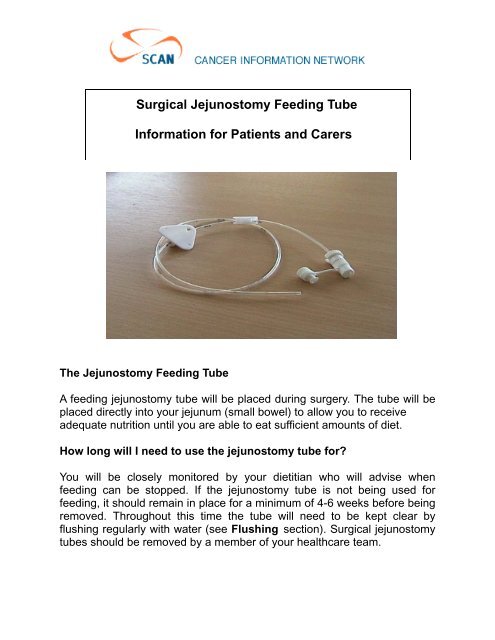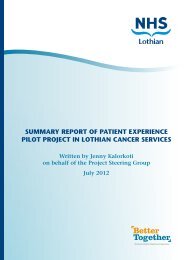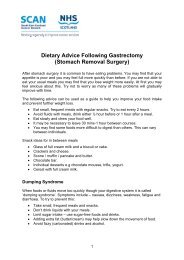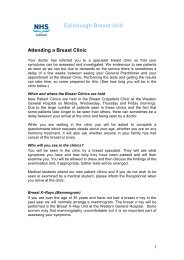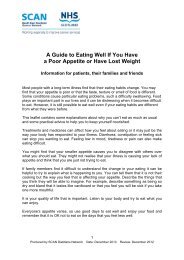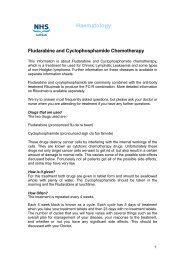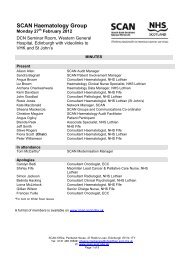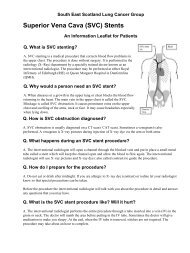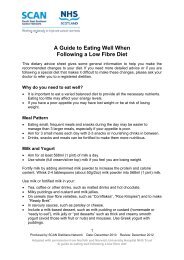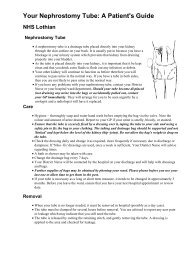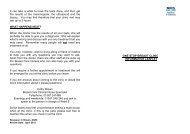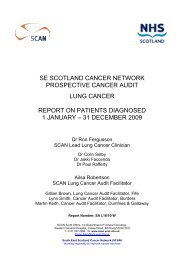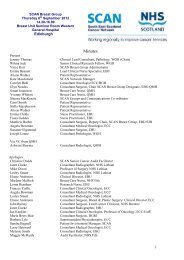Surgical Jejunostomy Feeding Tube Information for Patients ... - SCAN
Surgical Jejunostomy Feeding Tube Information for Patients ... - SCAN
Surgical Jejunostomy Feeding Tube Information for Patients ... - SCAN
Create successful ePaper yourself
Turn your PDF publications into a flip-book with our unique Google optimized e-Paper software.
<strong>Surgical</strong> <strong>Jejunostomy</strong> <strong>Feeding</strong> <strong>Tube</strong><br />
<strong>In<strong>for</strong>mation</strong> <strong>for</strong> <strong>Patients</strong> and Carers<br />
The <strong>Jejunostomy</strong> <strong>Feeding</strong> <strong>Tube</strong><br />
A feeding jejunostomy tube will be placed during surgery. The tube will be<br />
placed directly into your jejunum (small bowel) to allow you to receive<br />
adequate nutrition until you are able to eat sufficient amounts of diet.<br />
How long will I need to use the jejunostomy tube <strong>for</strong>?<br />
You will be closely monitored by your dietitian who will advise when<br />
feeding can be stopped. If the jejunostomy tube is not being used <strong>for</strong><br />
feeding, it should remain in place <strong>for</strong> a minimum of 4-6 weeks be<strong>for</strong>e being<br />
removed. Throughout this time the tube will need to be kept clear by<br />
flushing regularly with water (see Flushing section). <strong>Surgical</strong> jejunostomy<br />
tubes should be removed by a member of your healthcare team.
Hygiene<br />
• Hands should be washed, rinsed and dried be<strong>for</strong>e handling feed,<br />
feeding equipment, or the jejunostomy site to reduce the risk of<br />
infection.<br />
• For the first two weeks, do not have a bath. Showers are permitted.<br />
<strong>Jejunostomy</strong> Care<br />
• Check the jejunostomy site daily <strong>for</strong> any sign of redness, swelling or<br />
bleeding. If concerned, contact your nurse or GP.<br />
• Do not remove the stitches. Clean around the stitches with water<br />
daily. Dry thoroughly. If stitches become loose or come out, contact<br />
your GP, district nurse or hospital team.<br />
• Avoid the use of creams, lotions or powders at the jejunostomy site,<br />
unless advised to do so by your doctor.<br />
• Change dressings twice-weekly, or more frequently if there is any<br />
leakage. Some leakage is common and quite normal. Suitable<br />
dressings can be provided by your district nurse.<br />
Flushing<br />
Be<strong>for</strong>e you leave hospital you and/or your carer will be taught how to flush<br />
and care <strong>for</strong> the tube.<br />
• Use a syringe to gently flush the jejunostomy feeding tube with water.<br />
• Water <strong>for</strong> flushing should be freshly-drawn drinking or cooled boiled<br />
water as recommended by your nurse or dietitian.<br />
• Flush the tube with a minimum of 30 ml of water immediately be<strong>for</strong>e<br />
and after feeding.<br />
• To prevent blockage the tube should be flushed regularly 6-hourly<br />
throughout the day when there is a break in feeding.<br />
Medicines<br />
If you have been advised to take medicines through the tube:<br />
• These should be in liquid <strong>for</strong>m where possible.<br />
• If you have any concerns about your medicines, check with your<br />
pharmacist.<br />
• Always flush the tube with a minimum of 30ml water be<strong>for</strong>e and after<br />
the medicines.
<strong>Tube</strong> blockage<br />
• Flush the tube with 30 ml warm water or soda water can be used if<br />
you find that the feeding tube has become difficult to flush.<br />
• If you are unable to flush the feeding tube, contact your district nurse,<br />
dietitian or hospital team.<br />
<strong>Feeding</strong><br />
• If you have been advised to continue feeding at home your dietitian<br />
will discuss with you the method and timing of feeding to suit you best.<br />
• Never put anything other than your prescribed feed, water or<br />
prescribed medicines down your jejunostomy tube.<br />
• Do not lie completely flat when feeding. Support your upper body<br />
with pillows or cushions.<br />
• Your dietitian will continue to monitor your progress and give advice<br />
about eating.<br />
Discharge Supplies<br />
On discharge from hospital you will be given a seven day supply of all the<br />
necessary feed and equipment. e.g. dressings, syringes.<br />
Note: The in<strong>for</strong>mation in this leaflet is intended only as a general guide. It<br />
should not replace the advice of your doctor or health care team.<br />
Produced by <strong>SCAN</strong> Dietitians Network<br />
Pictures used with kind permission from Fresenius Kabi<br />
Date: October 2009<br />
Review: October 2011


